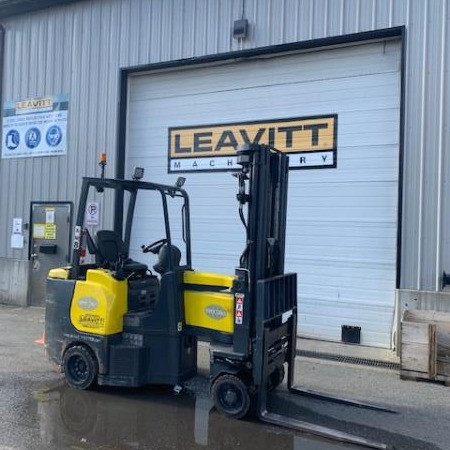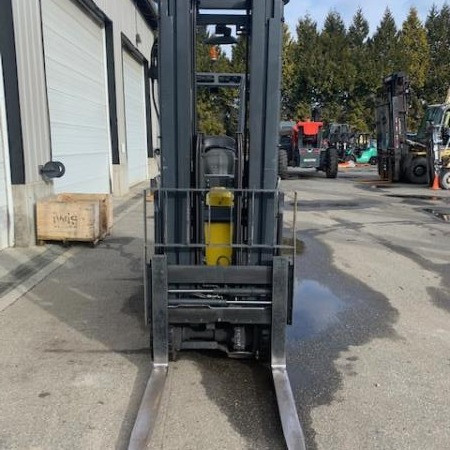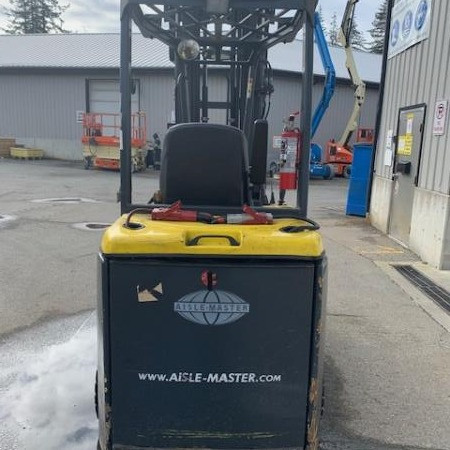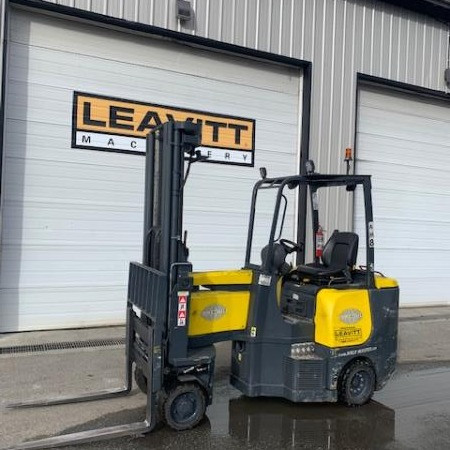Very Narrow Aisle Forklift San Bernardino
Used Very Narrow Aisle Forklift San Bernardino - Getting items from one warehouse location to another and to and from the loading docks is the focus of warehousing. Focus is often on space saving tools and the layout of the building. Narrow aisles need specific solutions to allow goods to be accessed and stored properly. More space can be given to storage as less space is needed for accessing the aisle. These warehouse configurations are often referred to as warehouse optimization.
Warehouse Optimization
There are several significant benefits of implementing very narrow aisle warehouse optimization.
Using narrow forklift trucks instead of traditional forklifts can enable the warehouse width of the aisles can be lessened to half. Numerous narrow aisle forklifts deliver better stacking heights to increase the storage capacity on a square foot basis. Costs can be drastically decreased with a narrow aisle forklift compared to a standard aisle configuration as less warehouse space is required for the same quantity of stock. In most urban areas where square footage is very costly, this is a huge benefit to warehouse operations. Adding a very narrow aisle width system can increase storage up to eighty percent when planned properly. This warehouse design creates more rack faces and increased product access. Reduced travel time for storing items and gathering products are some of the key benefits to this warehouse layout as more products are found in an accessible location.
It is common for warehouses to use a very narrow or narrow aisle layout. Narrow aisles are measured as those that use fewer than eleven feet of aisle width. These widths reduce even further to roughly 6.5 feet for very narrow aisles. Both of these aisle widths provide significantly increased storage opportunities. However, they also create challenges when turning within the aisles using forklifts for stocking and order picking. These challenges are met by using very narrow forklifts to gain access and complete tasks.
Before choosing a forklift for a particular job, it is vital to know the dimensions of the aisle. Taking note of the proper dimensions will save valuable time and money by avoiding the mistake of acquiring a forklift that will not work in the intended application. It is essential to take any columns, posts or utilities into account before deciding a type of narrow aisle forklift design as these can block access.
Very Narrow Aisle Forklift Trucks
As these units are mostly powered by electricity, rechargeable batteries are popular for very narrow aisle forklifts. Very narrow aisle forklift trucks are popular as stand-up riders to help increase operator comfort and productivity. The most commonly used types of very narrow aisle forklift trucks are:
1. Reach trucks
2. Order pickers;
3. End-control riders; and
4. Turret or swing-mast.
Reach Forklift Trucks
Developed as a kind of rider stacker forklift, the reach forklift trucks can be configured for narrow aisle locations. The reach trucks developed their name from their forward-reaching actions to get a load. There are two types of reach trucks: the moving mast and the moving carriage. The moving carriage works by raising and lowering the carriage and the driver. The moving mast works by raising and lowering the forks along the mast, while the operator stays at ground level. The moving reach truck is typically considered the safest out of the two kinds of reach trucks. Reach trucks use a pantograph system, a type of jointed framework, which allows the operator to reach for or place a load without the need to move the forklift itself.
Order Pickers
Order pickers have been created to pick items from difficult, high racking systems. These machines are used for picking up lighter stock that can be moved by hand. Order pickers elevate the operator to the level of goods to pick and identify particular items required for filling an order.
End-Control Riders
End-control riders can pick up loads along the floor level and transport goods horizontally instead of transporting items over heights.
Turret or Swing-Mast Forklift
The turret or swing mast very narrow aisle forklifts have a swivel mast that pivots and articulates. Pallets can be set on either the right or left side of the forklift due to the machine’s ability to use its’ swinging mast.
Guided Very Narrow Aisle Trucks
Rail or wire can guide the very narrow aisle forklift trucks down the aisle securely.
Because the forklift is guided, thereby reducing the possibility of the forklift bumping racks while moving down the aisle, the aisles can be extremely narrow. Rail-guided applications use special rails set into the floor on either side of the aisle, funning the length of the location and curving around the edge. The forklift is fitted with special wheel guides that slide into the rails, preventing the forklift from moving outside the rail guards.
The wire-guidance system requires that the wires be installed into the floor, along the center of the aisle. The wire-guides function similarly to the rail systems except the forklift has a wire-guide system to prevent the machine from traveling where it is not supposed to.
Work Site Considerations
To use a narrow aisle configuration, there are some key considerations that need to be made. The floor and the rack construction needs to be evaluated to avoid any issues since the very narrow aisle units have extremely high racking systems. Four specific areas need to be perfectly prepared before a racking system can be implemented including a level floor, plumb racks, any floor cracks need to be repaired and the floor’s load capacity must be accurate. These locations need to be maintained and monitored continuously.
Level Floor
Because of the height of the racking systems, any slight slope of the floor is likely to negatively affect the plumbness of the racks, especially over time when loads are continuously placed and removed on the racks. Without this foundation of a level floor, the stability of the racks could be jeopardized.
Crack Repair
When there are floor cracks found, they need to be assessed and immediately fixed for safety concerns. The level of the floor can become unstable with cracks when they are only 3/8 inches wide. They will need to be filled properly with material as hard as the rest of the floor.
Floor Load Capacity
Minimum flooring requirements must be met before considering a narrow aisle installation. The floor should have three thousand psi concrete minimum and contain evenly distributed rebar at three to four inches under the surface. Depending on the configuration and load requirements, extra reinforcements may be necessary.
Plumb Racks
Of great importance is the proper installation of the racking system. Rack failure can happen if they are improperly installed. Every rack needs to be plumb to ensure a safe system and work environment. Rack shims can help the rack stay plumb to one inch at the height of thirty feet.
If the above measures are not taken or are improperly implemented, it is likely to cause a racking failure. Such failure is likely to result in costly damage to goods, the warehouse facility, forklifts and, worst of all, employees could be significantly injured or even killed. These measurements are vital to the success of installing a safe and productive narrow aisle configuration.
Very Narrow Aisle Forklift PDF
Stock Number: 208758 GL
Make: AISLEMASTER
Model: 44SE
Year: 2015
| Stock Number |
208758 GL |
| Make |
AISLEMASTER |
| Model |
44SE |
| Year |
2015 |
| Category |
Very Narrow Aisle Forklift |
Stock Number: 207213 GL
Make: AISLEMASTER
Model: 44E
Year: 2013
| Stock Number |
207213 GL |
| Make |
AISLEMASTER |
| Model |
44E |
| Year |
2013 |
| Category |
Very Narrow Aisle Forklift |
Stock Number: 209213 GL
Make: AISLEMASTER
Model: 44SE
Year: 2015
| Stock Number |
209213 GL |
| Make |
AISLEMASTER |
| Model |
44SE |
| Year |
2015 |
| Category |
Very Narrow Aisle Forklift |













